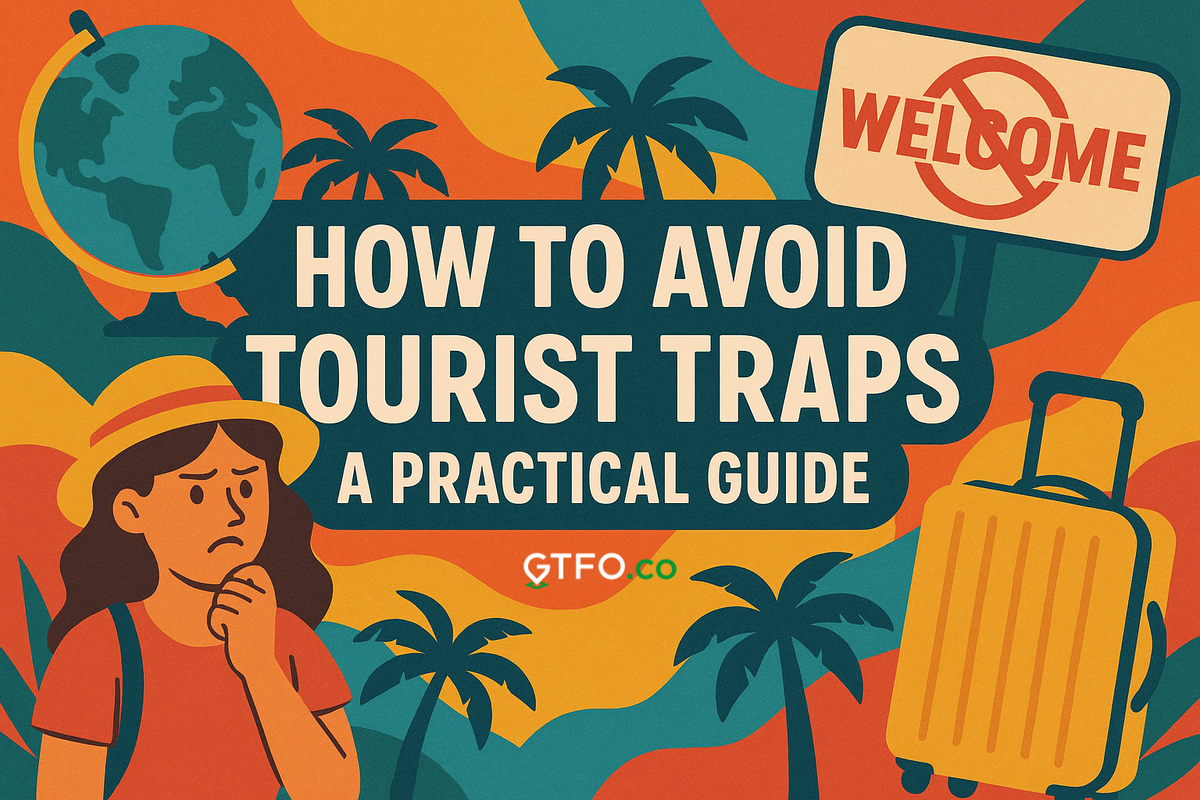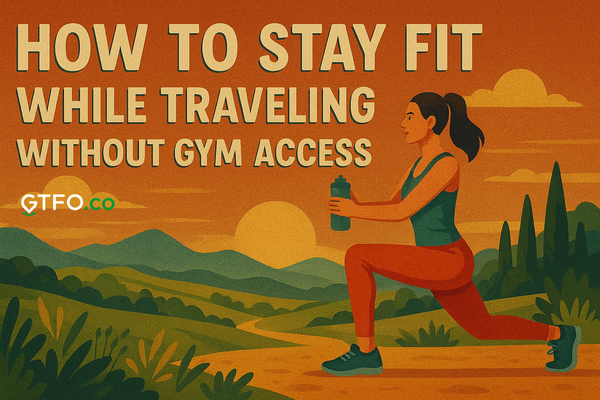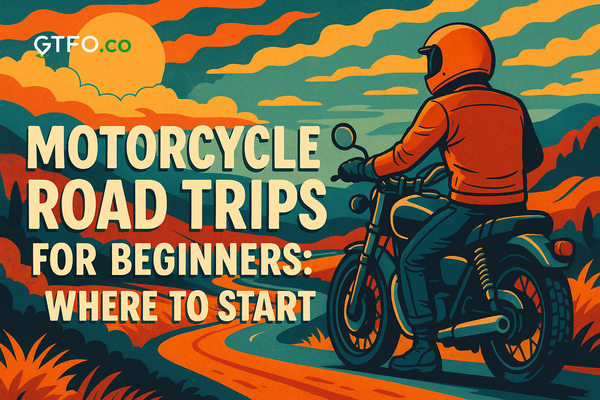How to Avoid Tourist Traps: A Practical Guide for Smarter Travel

Tourist traps can kill your budget, your vibe, and your time. Here’s how to spot them before they spot you, plus how to actually experience a destination without getting funneled into overpriced mediocrity.
Key Takeaways
- Trust locals, not loud signs or “#1” ratings plastered everywhere.
- Skip spots that have lines but no locals.
- Research smart, avoid anything that sounds like a “must-do” without context.
- Don’t overplan. Wandering helps you find real experiences.
- Walk more, Uber less. You’ll see what guidebooks don’t.
- Tourist traps aren’t just expensive, they’re often forgettable.

Why Tourist Traps Suck
Let’s be real: most tourist traps are about milking wallets, not making memories. Overpriced food, plastic souvenirs, crowds snapping the same photo—it’s travel on autopilot. You don’t need to waste your vacation doing what every influencer said was a “hidden gem” (spoiler: it’s not hidden if everyone’s already there).
Avoiding tourist traps doesn’t mean avoiding tourist sites. Some popular spots are worth it (shoutout to Machu Picchu and the Colosseum). The trick is knowing what’s worth your time and what’s just noise.

Spotting Tourist Traps Before You’re In One
1. The Menu Test
Restaurants with giant laminated menus in five languages? Pass. If they’re advertising pizza, burgers, and pad thai all on the same page, you’re not about to eat anything good. A local joint might have a small menu in the local language and still serve a knockout meal. Use Google Lens to translate if needed.
2. Overuse of Superlatives
“World’s Best Coffee.” “#1 Tour in [City].” “Most Authentic Experience.” These signs are less about truth and more about attracting people who didn’t do their homework. If something needs that much advertising, it probably isn’t that great.
3. Lines of Tour Buses
If you pull up to a spot and there are more tour buses than cars, it’s a strong sign the place exists to be sold, not explored. A lot of “famous” markets or cultural centers fall into this trap. The real gems are usually smaller, local, and quietly excellent.

How to Travel Smarter (and Actually Enjoy It)
1. Follow the Local Routine
Wake up when locals do. Eat when they eat. Head to neighborhood spots—not what TripAdvisor tells you is “can’t miss.” Locals don’t go to Madame Tussauds or overpriced observation decks. They grab street food, hang at quiet parks, and know the best café isn’t the one with the biggest sign.
2. Avoid Peak Times
If you're visiting somewhere big like the Eiffel Tower or Petra, go at sunrise or just before closing. Crowds thin out, and the experience feels more personal. If you want a view of a city, look for a public rooftop bar or hike, instead of paying $40 to cram into a tourist platform.
3. Take the Back Door Option
Some places are worth seeing, but not the way everyone sees them. Want to see ancient ruins without shoulder-to-shoulder tourists? Check this list of non-touristy ruins in Europe. Want to explore culture underground? Literally? Try this.

Tools That Actually Help
1. Use Google Maps Wisely
Search a place, then zoom out and look around. See what else is nearby. Sort restaurants by rating, but also check the number of reviews and photos. If all the food photos look the same, it’s probably generic. Bonus points for scoping out grocery stores and cafés a block or two off the main drag.
2. Reddit and Forums > Influencer Blogs
Travel subreddits, Nomad List, and niche travel forums are gold. You’ll get real advice from people who’ve just been where you’re going, not someone selling affiliate links for tour packages.
3. Walk More, Uber Less
The more you walk, the more you stumble on real-life stuff. You won’t find the best bánh mì or espresso bar from the backseat of a car. Plus, walking helps you get your bearings fast—ideal if you’re in a new city and trying to figure out what’s worth your time.

Ask Better Questions
Instead of googling “Top 10 Things to Do in Tokyo,” try these:
- “Where do locals eat in Shinjuku late at night?”
- “Most overrated tourist attractions in Paris?”
- “Walkable neighborhoods in Barcelona with good street food?”
- “Where to buy real handicrafts in Oaxaca?”
These get you better results and fewer regurgitated “must-see” lists.
Don’t Let Instagram Tell You Where to Go
That shot of someone alone in front of a Balinese temple? There were probably 30 people just out of frame. Social media is a highlight reel, not a reality check. If a place looks too perfect or like it’s always empty and magical—there’s a line out of frame, a drone overhead, and a guy selling “skip the line” bracelets.
Go places you’ve never seen on Instagram. Or do the big places differently. Like taking a motorcycle road trip through areas most tourists skip. Or building your itinerary around underrated places, like these warm weather spots.
Trust Your Gut (and Budget)
Some stuff’s just not worth it. Don’t pay $60 for a gondola ride in Venice if it feels cheesy to you. Don’t go to a cabaret in Bangkok if it’s packed with other tourists and priced 3x the local average. Travel’s personal—skip the FOMO. Spend where it matters: good food, solid gear, experiences you’ll actually remember.
If you’re trying to keep costs in check while still having a great time, check out this list of low-budget vacation ideas for couples. You don’t need a five-star resort to have a five-star trip.

Let Yourself Get a Little Lost
Some of the best experiences aren’t on a list or in a guidebook. Maybe it’s a tiny pub tucked behind a convenience store, or a beach you stumble across after missing your bus. Leave some blank space in your itinerary. Walk with no destination. Ask the bartender what to do tomorrow. You’ll find more than any Top 10 list ever gave you.
The Tourist Trap Red Flag List
Keep this checklist in your back pocket:
- Menu in 5+ languages
- Street hawkers aggressively pushing tours or souvenirs
- Every table filled with people holding maps
- Photos of food on the menu
- More signs in English than the local language
- Ticket prices that change depending on how “foreign” you look
- “Cultural” experiences with weirdly modern gift shops
- Giant stores claiming to be “authentic markets”
- Everyone has the same selfie stick, bag, or hat
Final Thoughts
Avoiding tourist traps isn’t about being a travel snob. It’s about making your trip yours. Tourist traps waste your time, burn your money, and usually leave you with a watered-down version of a place. You don’t need to swear off all popular spots—just be smarter about how you approach them.
You’re not there to be herded from gift shop to food court. You’re there to feel a place. To eat something that surprises you. To meet people. To remember why you went in the first place.
If you want to travel better, start by skipping the places that treat you like a walking wallet.





